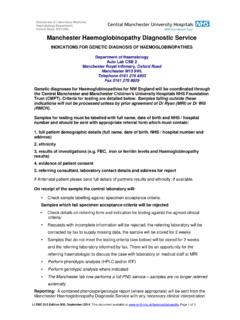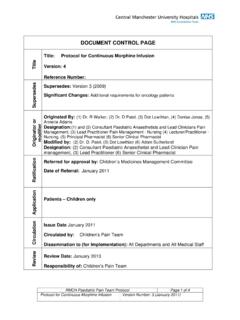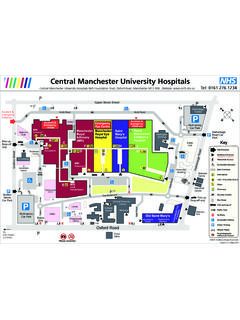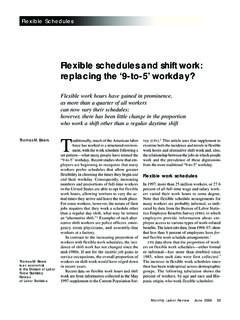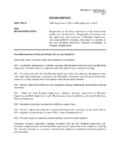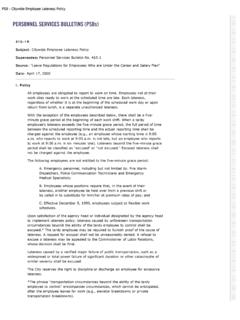Transcription of A shift in the right direction - cmft.nhs.uk
1 A shift in the right directionRCN short guidance on the occupational health and safety of shift working nurses and health care assistants the occupational health and safety of shift working nurses and health care assistants2A shift in the right directionThe reality of 24-hour health care delivery means many health care workers are required to work a variety of shift patterns. Adapting to shift patterns or changes in shift patterns can be difficult and if the associated risks are not managed properly this can lead to ill health and fatigue in a worker, which in turn can have an impact on patient RCN believes that more needs to be done by employers and others to protect the health and safety of nurses and other health care works who work short guide highlights the key occupational health and safety issues for shift workers, the duties on employers to reduce the risks to health care workers, and practical strategies that shift workers can take to make shift work easier.
2 If you are a student about to do your first night shift , or a newly-qualified nurse or a health care assistant doing shifts for the first time you may find some of these strategies details can be found in the accompanying full length version of this resource A shift in the right direction (RCN, 2012) publication code 004 285, which is available for download at is the occupational health and safety of shift workers important?As humans we have a 24-hour body clock called a circadian rhythm. Controlled by the brain this regulates the times we sleep, wake and eat, our body temperature, pulse and blood pressure, and other important aspects of body function. As humans our circadian rhythms mean that we are active and perform best in the day and sleep at night. shift work , particularly night work , can disrupt these rhythms especially our ability to sleep and this can lead to health problems and fatigue.
3 The health and safety impacts of shift work are widely recognised. Long hours, fatigue and lack of rest breaks or time to recuperate between shifts are associated A shift in the right directionRCN guidance on the occupational health and safety of shift work in the nursing workforceroyal college of nursing3with an increased risk of errors, all of which can impact on patient safety. Long-term exposure to shift work has also been associated with health issues including chronic sleep deficit, gastrointestinal problems, cardiovascular problems, depression, cancer and an increased susceptibility to minor illnesses such as colds and gastroenteritis (Health and Safety Executive, 2006). Some groups of workers may be more vulnerable to the health risks than others for example those with long-term conditions, pregnant workers and older workers who have worked shifts for a number of years.
4 Some shift systems have less impact on the health, safety and wellbeing of staff and patients and organisations need to implement optimal shift patterns for example, a forward rotating shift pattern in which a worker moves from an early to a late to a night shift is better. What to expect from your employerUnder health and safety laws your employer has a duty to protect your health, safety and wellbeing at work and ensure that any health and safety risks from shift work are properly managed. They also have to ensure that they comply with the Working Time Regulations (WTR) 1998 which set limits on daily and weekly working hours, and provide rest breaks during shifts and between shift changes. Employers need to assess the risks from shift work , identify staff at risk (including those who may be more vulnerable to working irregular hours or nights) and put in place measures to reduce the risk.
5 There are a number of evidence-based good practice recommendations that help reduce and manage the risks from shift work , and examples of these are detailed on page 6. Under the Workplace (Health, Safety and Welfare) Regulations 1992 your employer should also provide facilities for you to eat meals at work and to prepare or obtain a hot drink. If hot food cannot be obtained in or reasonably near to the workplace, an employer should provide workers with means for heating their own food (for example, a microwave oven).Pregnant workers may be more vulnerable to night shift work and working long hours. If a specific risk has been identified to the pregnant worker and/or her GP or midwife provides a certificate stating she should not work nights, her employer must offer suitable alternative day time work on the same terms and conditions.
6 If that is the occupational health and safety of shift working nurses and health care assistants4not possible, the employer must suspend her from work on paid leave for as long as is necessary to protect her health and safety and that of her unborn with long-term conditions may also be covered under the Equalities Act 2010 which requires employers to make reasonable adjustments to the employment of disabled workers. For example, if a condition is exacerbated or difficult to control due to shift working patterns the employer would be required to make changes to those working arrangements as a reasonable adjustment to support the durationThere has been much debate over the benefits and risks of eight-hour shifts versus 12-hour shifts , both within nursing and occupations outside health care. Evidence on the impacts on patient outcomes and staff safety are often conflicting.
7 The Working Time Regulations are not specific on the length of a shift but generally require workers to have an 11-hour rest period between working days. The Health and Safety Executive (HSE) points out that for the first eight to nine hours in a shift , the accident risk is constant, but after 12 hours the risk approximately doubles and after 16 hours it trebles (HSE, 2012). While most of the research on accidents and working hours has been carried out in other industries, working long hours with inadequate rest breaks clearly has the potential to impact on patient and staff safety in health care member surveys reveal that the majority of staff prefers 12-hour shifts , as they need to do fewer shifts and have more days off (RCN, 2009). The HSE also highlights that 12-hour shifts are popular as they make the working week shorter and may offer subsequent health and social benefits.
8 However, it also points out that any benefits to health and wellbeing are likely to be lost if the worker takes on overtime or a second job during their free time (HSE, 2006).In 2008, an RCN survey found that 45 per cent of respondents worked 12-hour shifts so this is already a reality in many nursing environments. If 12-hour shifts are to be implemented, in addition to consultation with staff and their representatives on proposed changes, the RCN recommends that employers put in place a number of safeguards that include adequate uninterrupted rest breaks during the shift , limiting the length to 12 hours, limiting the number of back-to-back shifts to two to three in a row, and ensuring protection of vulnerable workers. Ideally, workers should be given the choice of shift , with eight-hour shifts running alongside 12-hour college of nursing5 Rest breaks Adequate rest breaks within shifts are essential to prevent excessive tiredness and fatigue and for rehydrating and refuelling when working in a physically demanding role.
9 Similarly, adequate rest time to recuperate between shifts is also important. The Working Time Regulations (WTR) state that when a shift lasts six hours or more, the worker is entitled to a minimum 20-minute rest break away from their direct workstation. The HSE advises employers to consider length of shift when scheduling the duration and frequency of breaks; for example a 20-minute break for a 12-hour shift would be inadequate. Breaks are best taken before the onset of fatigue and the HSE advises workers should be given some discretion over when they take the break and that where the work is monotonous or demanding it is better to take shorter more frequent is increasing evidence of the benefits of a short restorative sleep during night shift breaks. In 2006, the Royal College of Physicians recommended that junior doctors working the night shift take a power or restorative nap of between 20-45 need to consider the evidence base promoting the benefits of power napping on a night shift break and put appropriate policies and resources (for example, adequate supervision and rest room facilities) in place to support power napping.
10 Health care workers need to be aware of their local policies and should not sleep on night duty breaks unless they have prior permission to do so by their organisational policy or in writing from their manager or supervisor. the occupational health and safety of shift working nurses and health care assistants6 Good practice recommendations for shift work Avoid scheduling demanding, dangerous, monotonous and/or safety-critical work during the night, early morning, towards the end of long shifts and during other periods of low alertness. Avoid placing workers on permanent night shifts . If possible offer workers a choice between permanent and rotating shift schedules. Where possible, adopt a forward rotating schedule for rotating shifts rather than a backward-rotating shift schedule. Either rotate shifts very quickly (every two to three days) or slowly (every three to four weeks) and avoid weekly/fortnightly rotating shift schedules.

